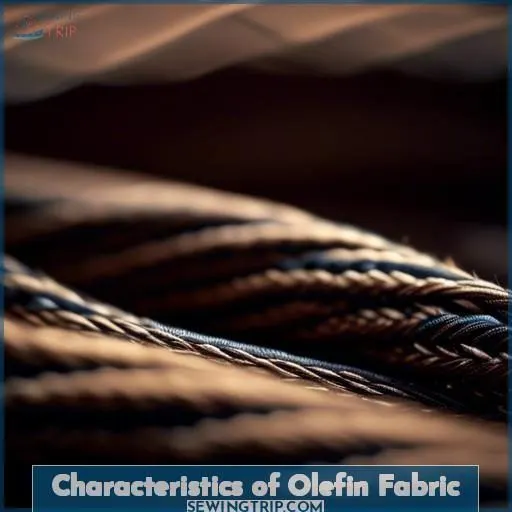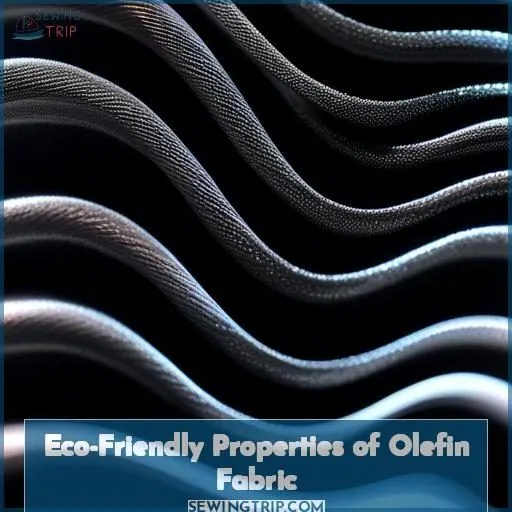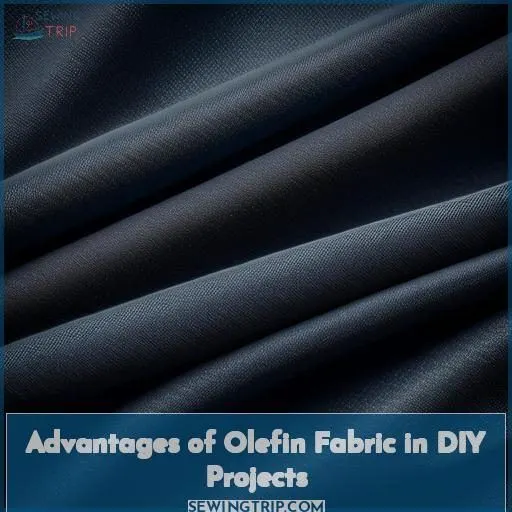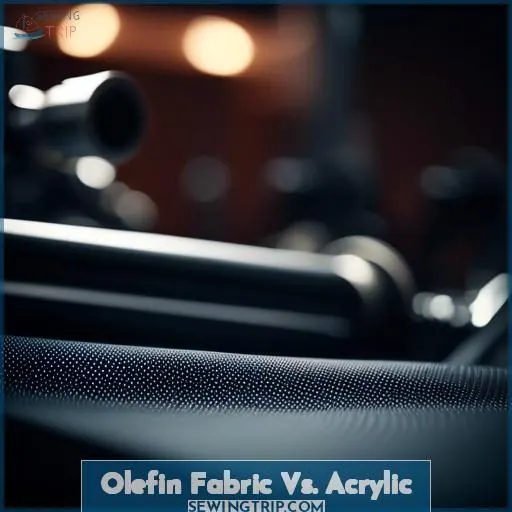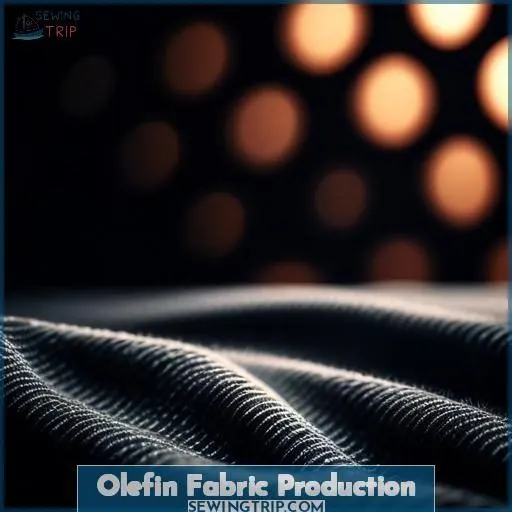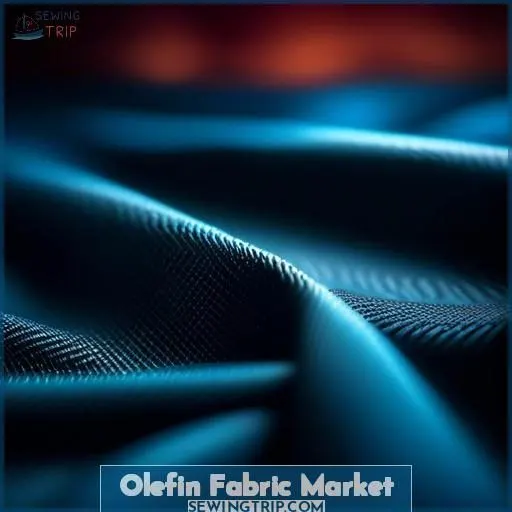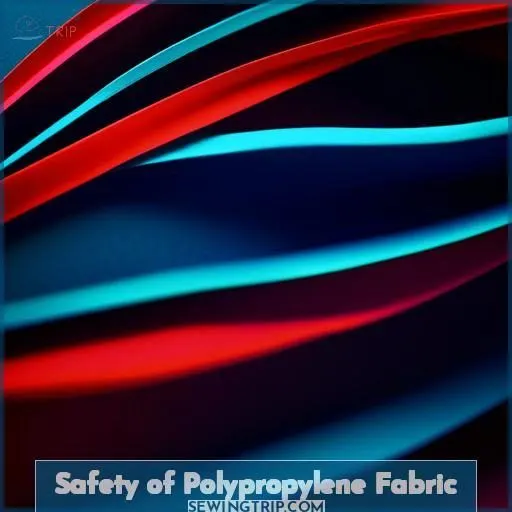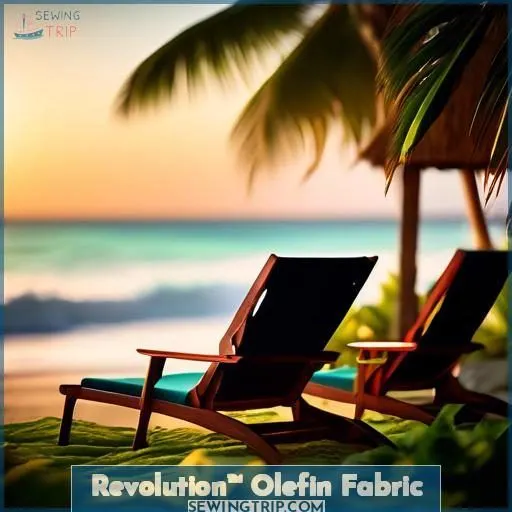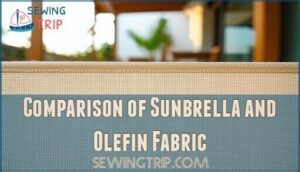This site is supported by our readers. We may earn a commission, at no cost to you, if you purchase through links.
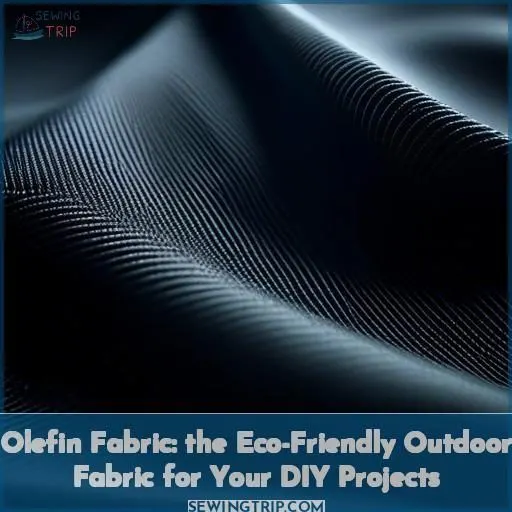
Olefin fabric is a durable, water-resistant, and eco-friendly synthetic fiber made from polypropylene. It’s known for its vibrant colors, resistance to stains, abrasion, mold, and mildew, making it a popular choice for outdoor furniture, carpeting, and automotive interiors.
Olefin fabric first emerged in Italy in 1957 and gained widespread use in the US by 1960. Its production process minimizes environmental impact, as it uses no water or land.
With its superior performance and budget-friendly nature, olefin fabric has become a go-to material for many DIY projects.
Table Of Contents
- Key Takeaways
- What is Olefin Fabric?
- What is Olefin Fabric?
- Characteristics of Olefin Fabric
- Eco-Friendly Properties of Olefin Fabric
- Advantages of Olefin Fabric in DIY Projects
- Olefin Fabric Vs. Acrylic
- Olefin Fabric Production
- Olefin Fabric Market
- Safety of Polypropylene Fabric
- Revolution™ Olefin Fabric
- Comparison of Sunbrella and Olefin Fabric
- Frequently Asked Questions (FAQs)
- Conclusion
Key Takeaways
- Olefin fabric is a synthetic fiber made from polypropylene, a byproduct of ethylene production in the oil industry. It was first created in Italy in 1957 and production in the USA began in 1960.
- Olefin fabric is known for its durability, resistance to water, stains, abrasion, mold, and mildew, and its vibrant colors, which are added during the melting process for a bleach-cleanable fabric.
- Olefin fabric is eco-friendly, using no water or land in its production, and is made from previously considered waste materials from oil production. It is commonly used in outdoor furniture, carpeting, automotive interiors, tote bags, and sports clothing.
- Olefin fabric is budget-friendly, making it a popular choice for DIY projects due to its superior performance and low environmental impact.
What is Olefin Fabric?
Olefin fabric is a durable and eco-friendly material made from synthetic polypropylene fibers, ideal for outdoor furniture and textiles due to its resistance to stains, moisture, and fading.
What is Olefin Fabric?
Olefin fabric is a synthetic fiber made from polypropylene, a byproduct of ethylene production in the oil industry. It was first created in Italy in 1957, and production in the USA began in 1960.
Olefin has a low environmental impact, using no water or land in its production, and is made from previously considered waste materials from oil production. It’s known for its durability, resistance to water, stains, abrasion, mold, and mildew, and its vibrant colors, which are added during the melting process for a bleach-cleanable fabric.
Olefin is commonly used in outdoor furniture, carpeting, automotive interiors, tote bags, and even sports clothing due to its versatility and performance.
Characteristics of Olefin Fabric
Olefin fabric, a synthetic polyolefin, has a rich history. It was first created in Italy in 1957, and production began in the USA in 1960. This eco-friendly fabric is known for its versatility and can be used in various textile applications, including DIY projects.
Olefin fabric is made from propylene gas, a co-product of ethylene production, and is upcycled from waste material. It is resilient, colorfast, and stain-resistant, making it ideal for outdoor use. Olefin fabric is also moisture-resistant, drying quickly, and UV-resistant, ensuring it stays bright and beautiful for years.
The fabric is available in a wide range of colors, weaves, and textures, catering to different design preferences. Olefin fabric suppliers offer easy cleaning instructions, typically involving spot cleaning as needed.
Eco-Friendly Properties of Olefin Fabric
Shifting gears from the sturdy characteristics of olefin, let’s explore its environmentally friendly qualities that make it a standout for outdoor furniture. This fabric promotes eco-friendly production, featuring reduced waste and recyclable fibers. Additionally, with low VOC emissions, it’s gentle on the planet.
Olefin’s environmental impact is as minimal as its texture, making it the preferred green choice for your eco-conscious DIY projects. It’s a welcome addition to water conservation, avoiding the need for H2O in its creation.
Advantages of Olefin Fabric in DIY Projects
Regarding DIY projects, olefin fabric provides numerous benefits compared to other fabric choices. Its superior durability makes it highly resistant to wear, suitable for areas with heavy foot traffic. It also comes in a diverse range of textures and weaves, broadening the design options for your project.
Olefin fabric requires minimal upkeep, making it easy to maintain. Its colors and patterns remain vibrant, and it resists mold and mildew growth. Additionally, it’s impervious to oil and gas, making it an excellent choice for outdoor projects.
When selecting olefin fabric, factor in the cost and your intended applications. Seek out reliable olefin fabric suppliers to guarantee the quality of materials for your project.
Olefin Fabric Vs. Acrylic
Regarding selecting the appropriate fabric for your DIY endeavor, you may be undecided between olefin and acrylic. Both fabrics possess distinct characteristics and advantages, but understanding their disparities can aid in making an informed decision.
Olefin fabric, a synthetic polymer derived from polypropylene, is renowned for its longevity and resistance to staining, mildew, and discoloration. Its water-resistant and quick-drying properties make it an ideal choice for outdoor projects where comfort is paramount. Additionally, olefin is environmentally friendly, with a minimal carbon footprint and recyclable fibers.
Acrylic, conversely, is a synthetic fiber known for its softness and low-maintenance nature. It resists stains, mildew, and fading, and is also water-repellent and quick-drying. However, acrylic lacks the durability of olefin and may be susceptible to pilling and snagging.
In terms of cost, olefin is typically more economical than acrylic, making it a budget-friendly alternative for DIY projects.
When comparing olefin and acrylic, it’s crucial to account for the specific requirements of your project. If you seek a fabric that’s both durable and comfortable, olefin may be the superior option. However, if you prefer a softer fabric that’s easy to care for, acrylic could be the better choice.
Ultimately, the decision between olefin and acrylic hinges on your project’s specifications and your individual preferences. Take the time to evaluate the advantages of each fabric and select the one that best aligns with your needs.
Olefin Fabric Production
Olefin fabric, also known as polypropylene, is a synthetic fabric made from propylene gas, a byproduct of ethylene production in the oil industry. The production process of olefin involves polymerizing high-purity propylene gas in the presence of an organometallic catalyst at relatively low pressures and temperatures. The resulting polypropylene is then melted and extruded into thread, which is used in various textile applications.
Olefin fabric has several advantages over traditional textiles like cotton or wool. It uses no water or land in its production, making it a more eco-friendly choice. Additionally, it’s made from previously considered waste materials from oil production, aligning with global sustainability goals by reducing reliance on petroleum reserves.
However, it’s worth noting that the production of olefin fabric does involve the use of chemicals and energy, which can have environmental impacts. Some studies suggest that more efficient and environmentally friendly production methods, such as those using biomass and bio-waste in olefin production, are being explored.
Olefin Fabric Market
The olefin fabric market has been experiencing significant growth in recent years, driven by the increasing demand for sustainable and durable textiles. According to a report by The Insight Partners, the global olefin fibers market is expected to witness high growth during the forecast period, with a market size and forecast from 2020 to 2028. The market is segmented into solid and hollow fibers, and its applications include nonwovens, industrial fabrics, and others.
One of the key factors contributing to the growth of the olefin fabric market is its eco-friendly properties. Olefin fabric is made from synthetic polyolefins, which are derived from previously considered waste materials from oil production. Its production process generates minimal waste, and the fabric can be recycled up to ten times. Additionally, the shift to alternative feedstocks like biomass for olefin production is in line with global sustainability goals by reducing reliance on petroleum reserves.
Another factor driving the market is the versatility of olefin fabric. It’s used in various applications, such as outdoor furniture, carpets, and industrial products, due to its resistance to water, stains, abrasion, mold, and mildew. Its durability and ease of maintenance also contribute to its popularity.
In terms of fiber applications, olefin fibers are used in the production of recyclable packaging materials, eco-friendly area rugs and carpets, and indoor/outdoor cushions. Olefin fabric is also used in the fashion industry for activewear and outdoor gear due to its moisture-wicking properties and lightweight nature.
The olefin fabric market is expected to continue growing in the coming years, driven by the increasing demand for sustainable and durable textiles. As consumers become more conscious of the environmental impact of their purchases, the demand for eco-friendly materials like olefin fabric is expected to increase.
Safety of Polypropylene Fabric
When you’re eyeing sustainable textile options, polypropylene composition stands out. It’s the backbone of what’s olefin fabric, ensuring your DIY projects stay vibrant; colors and patterns won’t fade.
You’ll breathe easy knowing health concerns are minimal, as olefin shuns the need for harsh chemical treatment alternatives.
The environmental impact of production is a sigh of relief, with a warranty of safety from revolution performance fabrics.
Rest assured, your outdoor oasis will be both eco-friendly and enduring.
Revolution™ Olefin Fabric
Revolution™ Olefin Fabric is a high-quality, eco-friendly option for DIY projects. It is made from polypropylene, which is produced from propylene gas, a co-product of ethylene production, and upcycled from waste material.
Unlike some other fabrics, Revolution™ Olefin Fabric avoids harmful chemicals like antimicrobials and fire retardants. It is durable, colorfast, and resistant to staining, making it a great choice for outdoor projects.
The fabric is solution-dyed during melting, ensuring colorfastness and reducing water usage.
Comparison of Sunbrella and Olefin Fabric
When comparing Sunbrella and Olefin fabrics, it’s crucial to evaluate their performance in various aspects. Sunbrella stands out for its exceptional durability and resistance to wear and tear, making it a popular choice for outdoor furniture. It also exhibits resistance to stains, mildew, and fading, ensuring a long-lasting, vibrant appearance.
In contrast, Olefin fabric is also durable, but it may exhibit wear and tear in high traffic areas. It’s water repellent, UV-resistant, and quick-drying, making it suitable for outdoor applications. Olefin is also low maintenance, requiring minimal cleaning and care.
Regarding stain resistance, both fabrics are resistant to stains, but Sunbrella is renowned for its exceptional resistance to stains from food, drinks, and other spills. Olefin’s chemical composition provides stain resistance, but it may require more frequent cleaning than Sunbrella.
Ultimately, the selection between Sunbrella and Olefin hinges on your specific requirements and preferences. If you seek a fabric that can withstand high traffic and requires minimal maintenance, Olefin might be the better option. However, if durability and stain resistance are your top priorities, Sunbrella is a great choice.
Frequently Asked Questions (FAQs)
What is the origin of olefin fabric?
Olefin fabric was first created in Italy in 1957, then production began in the USA in This synthetic fabric is made from polypropylene gas, a byproduct of ethylene production – a clever upcycling process.
What are the primary applications of olefin fabric?
You can use versatile olefin fabric for all sorts of outdoor projects – think plush upholstery, comfy cushions, and billowing curtains that resist fading and weather. It’s a durable, eco-friendly choice that brings style and comfort to your space.
How does olefin fabric compare to other synthetic fabrics like polyester and nylon?
Olefin leaves polyester and nylon in the dust – it’s a durable, eco-friendly chameleon that can weather any storm, caressing your senses with its soft yet sturdy embrace. Realize your inner designer’s dream with this versatile marvel.
What are the environmental concerns associated with olefin fabric production?
While olefin is an eco-friendly fabric, its production still involves petrochemicals. The good news? Revolution Performance Fabrics uses olefin without any harmful chemicals, giving you an environmentally-conscious option for your DIY projects.
How does olefin fabric perform in extreme temperatures?
Olefin fabric’s robust performance shines in both sizzling heat and icy cold. It resists warping, shrinking, or cracking, keeping your outdoor furnishings looking sharp through Mother Nature’s extremes. Olefin’s weather-resistant magic means you can relax and enjoy the great outdoors.
Conclusion
Assuredly, olefin fabric holds the key to realizing your DIY aspirations.
You’ll be the talk of your community with its vivid hues, stain-defying properties, and environmental consciousness.
Don’t compromise – harness the potential of olefin fabric and effortlessly revamp your outdoor areas.
Its cost-effective nature is an added bonus.
Prepare to embark on your next endeavor and discover the wonders of this adaptable synthetic fiber.

